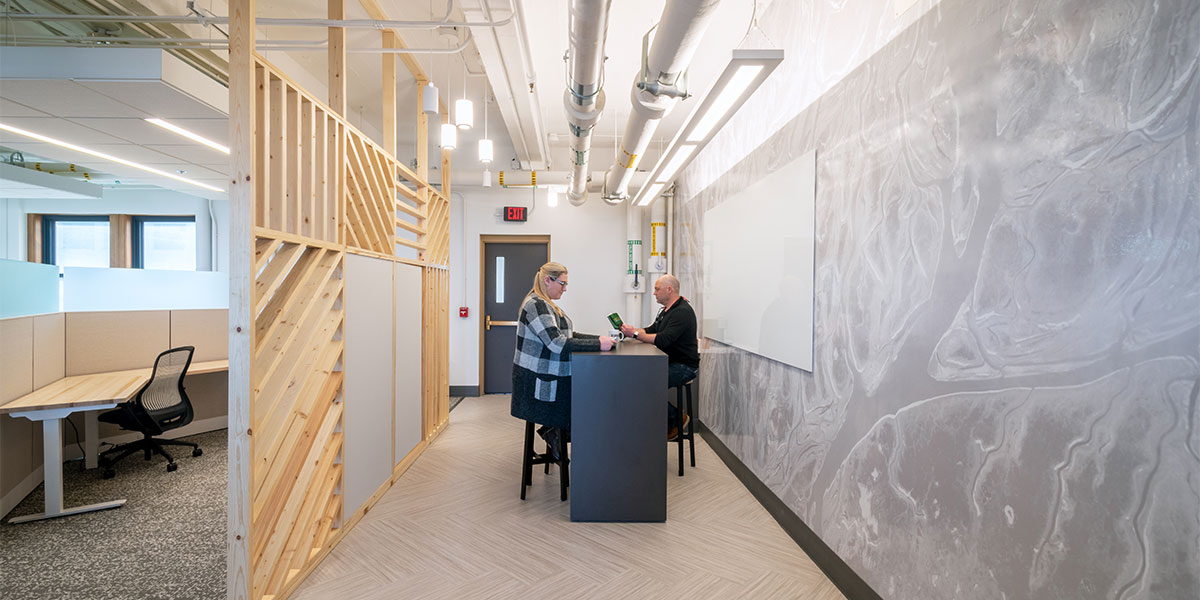Awards
IIDA Wisconsin
Award of Excellence - Work under 5,000 SF
2023
OBJECTIVE:
Fresh Fit-Out
When the U.S. Geological Survey (USGS), Water Mission Area (WMA) moved across town to the USDA Forest Products Lab building, they partnered with Strang to renovate the old, outdated 3rd floor into a fresh and collaborative space.
The USGS’s goal was to fit the space out to make it as comfortable and healthy for staff as possible. This project started at the beginning of the COVID pandemic, so health concerns were as important as giving staff a physically comfortable space. The USGS also sought to use this office space as a place to celebrate sustainability, local materials, and the outdoors—all things that are at the core of their organization. Finally, this space needed to fit multiple work styles within a small area. Technology, collaboration zones and acoustical planning were all important elements to creating a productive space.
SOLUTION:
Health and Wellbeing
Concern for the comfortability, health, and wellbeing of their employees was at the forefront of this design. One example is outside air exchange system. This allows for a quicker exchange of fresh air which helps keep the space’s air clean and allows easier breathing. To further address COVID concerns, workspaces were also placed at 120-degree desk clusters and removable acrylics barriers were placed between desks. These can be easily removed later to further increase the open office feel.

Collaborative Planning
A main challenge of this space was its small square footage. The USGS has multiple offices throughout the US they work and communicate with. Employees required the ability to work (and use visual and audio technology) from multiple locations within the small office. Strang designed multiple areas to meet this need, including the standard office desks, a “kitchen” gathering area, a small collaboration zone in the middle of the office, and a larger collaboration zone at the back wall.
With so many employees required to fit into the small space, proper acoustics was also a top priority. Strang ended up designing the space for employees to have easy communication with neighbors, while retaining the ability for private conversations. Acoustical panel ceiling clouds were hung throughout the space and felt acoustic hung panels served double purpose as an interesting visual with their decorative laser cut design. A white noise sound masking system was also installed in the space. These devices hung around the office help control background noise by emitting a frequency similar to human speech, leading to greater speech privacy.
Creating Sustainability
The scientists of the USGS study the landscape of the United States, its natural resources, and the natural hazards that threaten it—sustainability and the outdoors are integral values of their organization. Strang celebrated these ideals through the use of natural and sustainable materials as much as possible. This included using linoleum floor tiles (instead of luxury vinyl tiles) and custom work tops from the local Menominee Tribal Enterprises for desks and conference room tables.
The use of wood is also a strong feature throughout the space. These wood accent walls are not only visually appealing but are used to hold acoustic panels. They also serve as a workable surface to tack things up. Further cementing the biophilic design, plants are abundant throughout the space. Lastly, a digital “whiteboard” was added to an entire wall using a greyscale satellite image of the Yukon Territory from the USGS’s own photo cache as a background. This impactful image, wood accents, sustainable materials, and the incorporation of water blues and forest greens throughout the space all celebrate the ethos of the USGS and their connection to nature.












